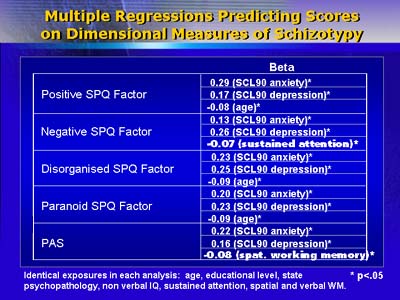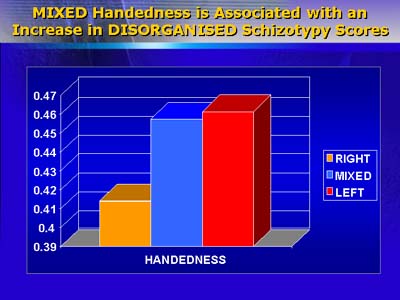Dr. Stefanis noted that schizophrenia generally presents as a psychotic illness, but it actually starts as a prodrome long before the patient becomes psychotic. There are known relations between schizotypal personality disorder and schizophrenia. The question Dr. Stefanis raises is "Does schizotypy put a person at risk of schizophrenia?"
Schizotypy is defined by a number of factors. Dr. Stefanis's group has designed a questionnaire to assess these characteristics. Their study utilizes mandatory conscripts into the Greek military as subjects. They currently have 1412 such male subjects who have consented to be prospectively studied.
Subjects are given the Schizotypal Personality Questionnaire. They also receive cognitive tests (the Raven, measures of verbal and spatial memory, and others) eye movement tests, psychometric examinations, and evaluation of genetic markers of the catechol-O-methyltransferase gene from blood. Last, they receive the Perceptual Aberration Scale as well.
The Questionnaire was analyzed by factor and found to fit a four-factor model. The factors are called "Positive," "Negative," "Paranoid," and "Disorganized." Researchers noted that the score on the Questionnaire is heavily influenced by the state of the subject at the time (including anxiety, fatigue, and others).

The "Negative" dimension is associated with poor performance on the continuous performance task and on tasks of working memory. Dr. Stefanis proposed that individuals who are isolative (meaning they have high "Negative" scores) may have a subtle encoding difficulty that predisposes them to do poorly on these tasks.
There is an association between mixed handedness (ambidexterity) and the "Disorganized" factor of the Questionnaire. This may be consistent with findings that patients with schizophrenia tend to have abnormalities in brain lateralization.

Genetically, there seem to be two types of catechol-O-methyltransferase alleles: One encodes for high activating enzyme and the other encodes for low activating enzyme. The researchers found an association between genotype and the scores on the Questionnaire and the Perceptual Aberration Scale.
.
Dr. Stefanis summarizd these findings, stating that there is an association between schizotypy and neuropsychiatric measures in normal healthy young adult males. There is an association between schizotypy and ambidexterity, and there is also an association between schizotypy and catechol-O-methyltransferase genotype. These findings may help form predictions of risk. However, the study subjects need to be studied longitudinally first.